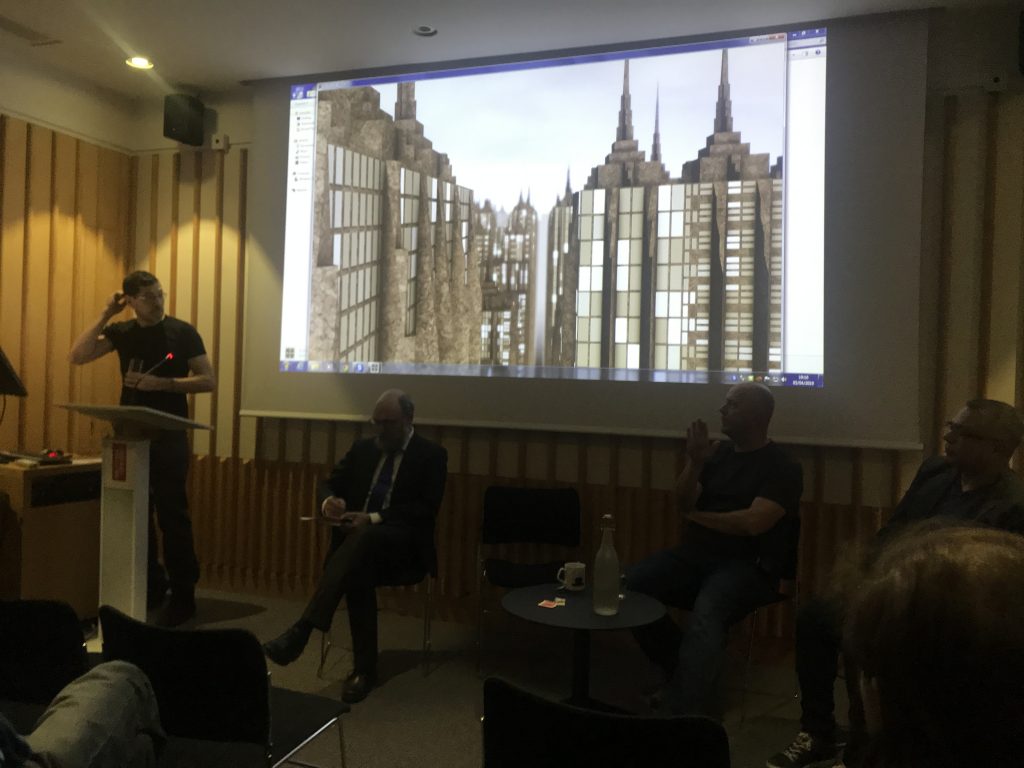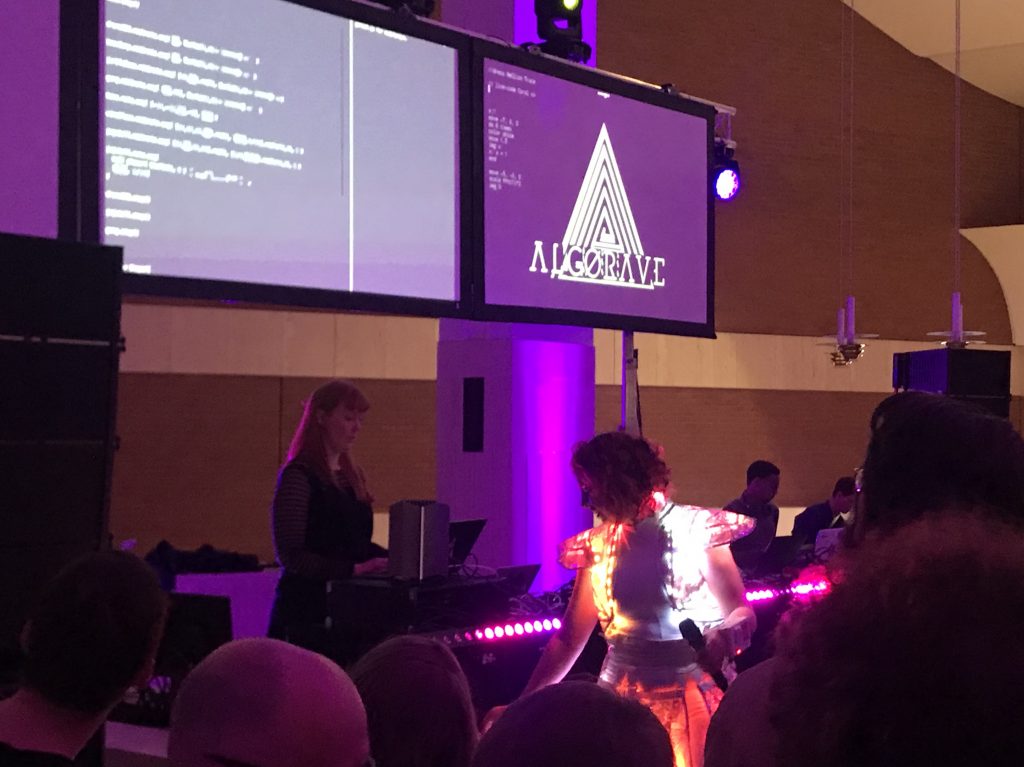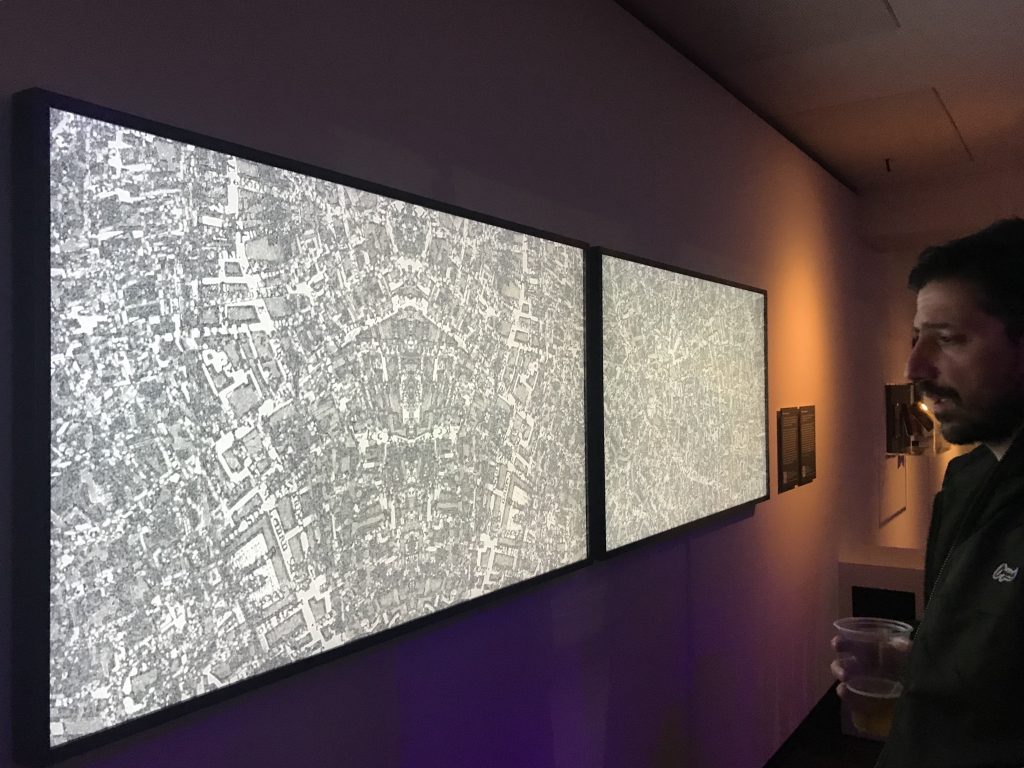British Library, 5th April 2019
The exhibition presents four technology-based installations that derive from images of 19th-century maps, and associated meta-data, held in the British Library digital collection, created by digital artist Michael Takeo Magruder (an artist in residence at the British Library) with collaborators Mahendra Mahey (British Library), Drew Baker (independent researcher) and David Steele (software architect).
Of particular interest in the development of my own work is the movement between analogue and digital. The maps themselves are exemplary analogue representations, which have been digitally archived. The archiving process produces not just a digital (re)presentation of the map, but adds meta-data to this (effectively a digital encoding of the narratives, for instance of origins, authorship, circulation, association, ownership and functions that become attached to and associated with the map as artefact). The meta-data itself becomes subject to processing, and thus available in the production of artwork relating to the maps. With the map as a point of origin, a data trail is formed, and from this artworks are created.
A conversation with artist Michael Takeo Magruder

The talk provided insight into the process of production of the work. Magruder is interested in production of tangible objects, including the use of traditional craft techniques. Outputs from this project include 3D and digital prints, and objects made with wood and gold – analogue and digital together. He also uses prosumer and consumer VR in to allow visitors to explore the imaginary city produced from maps of New York. He sees himself as applying the language of the visual arts to things that are ‘digitally born’. Previous work has been about visualising data; this is about visualising (digital) archives. Drew Baker explained the process of production of 3D visual content from real-time data (as an archaeologist he relates this back to the process of finding, extrapolating, understanding, archiving, disseminating and exploring archaeological material – lost and marginal spaces). David Steele, software architect, explored the process of building a continuous archive (with minimal intervention and maintenance) and processing of information. Interestingly, he presented the relationship between software engineers and artists in the production process as similar to Sol Lewitt’s use of instructions to galleries in creating exhibitions (this might also bring to mind Jeff Koons’ production of sculptural work – providing an instruction set, oversight, quality control, authentication).
It is clear that there is huge potential to draw on the BL digital collection and to do collaborative work. There are interesting questions to explore about the relationship between place (as represented in the maps) and the artworks (imaginary cities) produced, and the nature of the ‘processing’ (both analogue and digital) that sits between these. I was tempted to say that this is uni-directional (the process of creation of the work, but, of course, the viewer remakes a pathway back from the artwork (to another imaginary place). There are obvious analogies with my own current work, which creates imaginary scenarios from the manipulation of digital interaction between images. The starting conditions are ‘real’, in the sense that they are photographs of human activity and the environment in a particular place at a specific point in time (and we can therefore exercise our desire for the indexical promise of the photograph), from which a number of fictions are created by bringing the images together and varying the conditions of their interaction. Those conditions relate to the visual (in that they depend on the translation of colour into tones, and the combination of those tones). The question is, though, whether that is any more or less arbitrary than any other principle of translation. In the installations, numerical data (some derived from visual sources, some not) are translated into visual form. The principles (or, in other words, the algorithm, programme or software) by which this translation takes place can exhibit differing degrees of arbitrariness – an imaginary city can be generated from any starting point and develop according to any principle. However, the artist (if it is an artwork) has to account for this in their rationale (or intent).
One interesting observation about the process of creating an interactive environment was the use, by the programmer, of a cryptographic hash to obscure the relationship between the viewer and the effect on the work, to stop viewers from ‘gaming’ the system, and learning how to control it by getting a ‘feel’ for the algorithm.

The algorave (billed as ‘the world’s largest algorave in a national library ever’!) was also interesting in this respect. Here we have code generating sound (and visuals, through light shows and projections), some through intention, some through response to the environment, some through arbitrary or random processes (including glitches in the hardware, software, data, programmer). Heuristically, there are also questions about what we learn about the initial and final state, the process, about ourselves and others (as creators, as audience, as collaborators).
References
British Library Digital Scholarship Blog. Online https://blogs.bl.uk/digital-scholarship/ [accessed 24.04.19]
British Library Digital Scholarship Department. Onlinehttps://www.bl.uk/subjects/digital-scholarship[accessed 24.04.19]
Michael Tadeo Magruder. Online http://www.takeo.org/[accessed 24.04.19]


